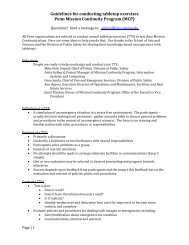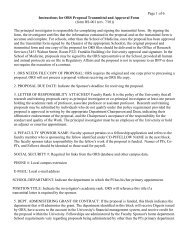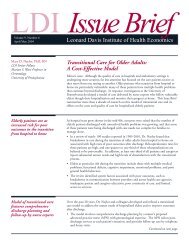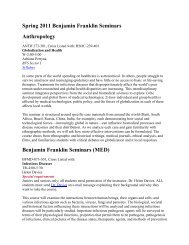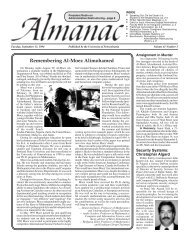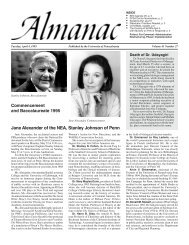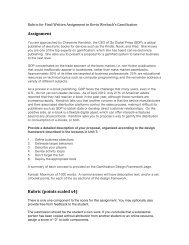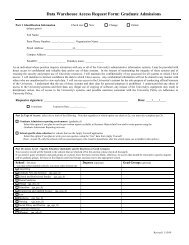Download this article (PDF) - University of Pennsylvania
Download this article (PDF) - University of Pennsylvania
Download this article (PDF) - University of Pennsylvania
Create successful ePaper yourself
Turn your PDF publications into a flip-book with our unique Google optimized e-Paper software.
across the grass or along the side paths<br />
on either side <strong>of</strong> the allées, and reach the<br />
triangular forecourt, you find yourself<br />
facing a large granite niche in which sits<br />
an oversized, disembodied bronze head<br />
<strong>of</strong> Roosevelt. He looks pensive, even a bit lonely, above the<br />
simple inscription: Franklin Delano Roosevelt 1882 -1945.<br />
From there you enter the three-sided Room. Open on its south<br />
side to a glittering expanse <strong>of</strong> water and light and a Lower<br />
Manhattan skyline that prominently features the United Nations<br />
building, its only ro<strong>of</strong> is the sky. There is no railing to block your<br />
view—just a ha-ha, a sort <strong>of</strong> granite trench at the prow <strong>of</strong> Kahn’s<br />
ship that seems to erase the boundary between its granite deck<br />
and the river. Behind you now, inscribed on the south-facing<br />
side <strong>of</strong> the statue niche, is an excerpt from Roosevelt’s 1941<br />
“Four Freedoms” speech, whose words give a hint <strong>of</strong> his ability<br />
(Above) Monumental stairs, trees, skyline.<br />
(Left) The not-so-Brazen Head <strong>of</strong> FDR greets<br />
visitors. (Far left) Mystery and Melancholy<br />
<strong>of</strong> a Room.<br />
to inspire a nation that was then slogging<br />
from Depression to war.<br />
The walls <strong>of</strong> the 60-foot-square Room<br />
are 12 feet tall—yet everything about it is<br />
both monumental and somehow … light.<br />
Its massive columnar cubes <strong>of</strong> granite are<br />
each separated by an inch, and the surfaces<br />
between them are honed to a reflective<br />
sheen, which allows the light to penetrate<br />
and dazzle. The faces are wire-sawn, to<br />
roughen their texture and capture subtle<br />
shades <strong>of</strong> light (and, in rain and fog, an<br />
almost sensuous patina). Clearly, you<br />
think, granite was the only medium that<br />
Kahn could have chosen for the Room.<br />
Except that it wasn’t. Stone was not his<br />
first choice <strong>of</strong> material. It wasn’t even his<br />
second. As with so many things about<br />
Four Freedoms Park, there was a remarkable<br />
amount <strong>of</strong> evolution, change, refinement,<br />
driven by concerns both budgetary<br />
and esthetic. Had he lived longer, who<br />
knows what else might have changed?<br />
Sitting at a long table in the Architectural<br />
Archives, Harriet Pattison<br />
looks shyly stylish in a brown sweater<br />
with a dark, high collar. Beside her<br />
are Nathaniel, a portrait <strong>of</strong> thoughtful<br />
intensity as he listens to and occasionally<br />
prompts his mother, and Whitaker,<br />
who lays out a series <strong>of</strong> sketches and<br />
models and documents before her as we<br />
talk. Some <strong>of</strong> the drawings are Kahn’s,<br />
many are hers, and they are kindling<br />
memories, most <strong>of</strong> them warm.<br />
February 20, 1973. She remembers the<br />
day well. It was Kahn’s 72nd birthday,<br />
and the day he brought the proposal for<br />
the memorial into her <strong>of</strong>fice.<br />
“I spent five hours on it,” she says, her<br />
memory precision-honed by the time cards<br />
in the archives. “I remember how Lou came<br />
in, pushed aside the stuff that I was working<br />
on, and laid out photographs and a site<br />
plan, a survey—just laid them out like a<br />
stack <strong>of</strong> cards and told me about it.<br />
“He was very excited,” she adds. “So was I. It was the best possible<br />
commission you can have.” Kahn’s proposal for the John<br />
F. Kennedy Library in Washington had recently been turned<br />
down, she recalls, as had one for another FDR memorial in that<br />
city. But <strong>this</strong> commission “was a great honor,” and the site had<br />
tremendous potential—especially for a landscape architect.<br />
“It had to involve landscape,” she says. “It was four acres.<br />
So unless you were building the Pentagon or something, you<br />
wouldn’t cover it altogether with architecture, although just<br />
an architect was hired for the job. So it was, from the beginning,<br />
a landscape and architecture thing.”<br />
THE PENNSYLVANIA GAZETTE MARCH | APRIL 2013 41





